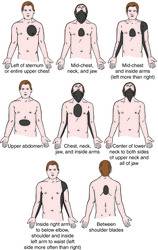Signs of myocardial infarction
Patients usually appear anxious and are often sweating profusely. The heart rate may range from marked Bradycardia (most commonly in inferior infarction) to Tachycardia resulting from increased sympathetic nervous system activity, low cardiac output, or arrhythmia. The blood pressure may be high, especially in former hypertensives, or low in patients with shock. Respiratory distress usually indicates heart failure. Fever, usually low-grade, may appear after 12 hours and persist for several days.
2. Chest
Clear lung fields are a good prognostic sign, but basilar rales are common and do not necessarily indicate heart failure. More extensive rales or diffuse wheezing suggests pulmonary edema.
3. Heart
The cardiac examination may be unimpressive or very abnormal. An abnormally located ventricular impulse often represents the dyskinetic infarcted region. Jugular venous distention reflects right atrial hypertension, which may indicate right ventricular infarction or elevated left ventricular filling pressures. The absence of elevated central venous pressure, however, does not indicate normal left atrial or left ventricular diastolic pressures. Soft heart sounds may indicate left ventricular dysfunction. Atrial gallops (S4) are the rule, whereas ventricular gallops (S3) are less common and indicate significant left ventricular dysfunction. Mitral regurgitation murmurs are not uncommon and usually indicate papillary muscle dysfunction or, rarely, rupture. Pericardial friction rubs are uncommon in the first 24 hours but may appear later.
4. Extremities
Edema is usually not present. Cyanosis and cold temperature indicate low output. The peripheral pulses should be noted, since later shock or emboli may alter the examination.

No comments:
Post a Comment